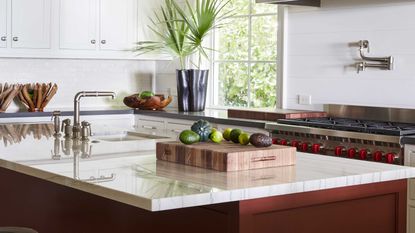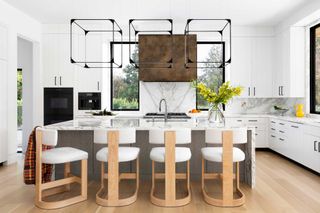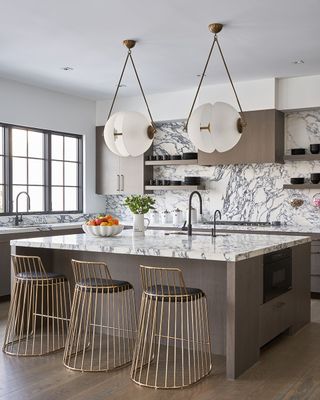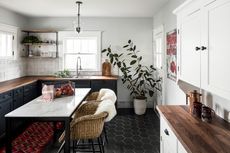What are the best countertops for cooking? The styles to consider for your kitchen if you love to cook
Whether you're looking for countertops to knead dough on or just one that holds up to red sauce stains, these are the best styles for budding chefs


Kitchen countertops are one of the most important decisions you’ll make when designing or refurbing your kitchen. Not only do they influence the aesthetic and overall feel of the space, but they can also be the making of a great chef. Though, get the wrong kitchen countertop, and you’ll likely end up with culinary nightmares and the type of colorful language witnessed in Gordon Ramsay’s kitchen.
On the flip side, the right countertop can be the perfect addition to your prep space. So, what types of countertops should a serious cook consider?

Sophie is a home interiors writer and all-around design aficionado. We asked her to investigate the best countertop choice if you love to cook. This is what the experts told her.
What makes a good countertop for cooking?
‘It’s important to ensure your chosen surface will be long-lasting and durable,’ says Jonathan Stanley, Vice President of Marketing at Caesarstone. ‘Kitchens are busy places, and the worksurface, more than any other part, really takes the brunt of this.’ You need to choose a countertop that can stand up to what you dish out.
‘A kitchen should be both ‘aesthetically beautiful and utterly practical,’ adds bespoke kitchen designer Tom Howley. ‘The right countertop elegantly ties a kitchen design together… and should confidently support you through a future of cooking and entertainment.’ It shouldn’t just look the part, but play it too.
Which countertops are least likely to stain?

‘Maintenance is one of the most important elements when choosing the worktop material for your kitchen,’ says Tom. ‘For those who like a spotless space, being able to wipe away spillages easily is a priority.’ Quartz is one of Tom’s go-to kitchen countertop materials, principally for its characteristic low-fuss and hardy qualities. The engineered stone is a combination of quartz stone particles and resin. ‘Quartz surfaces are durable and non-porous, making them less susceptible to staining, so cleaning up oil, juice, or coffee is as simple as one swipe,’ he explains. ‘And as well as being durable, quartz comes in a vast range of nature-inspired patterns and beautiful colors.’
Another countertop favored for its high-performance features, and design versatility is porcelain. Perfect for high-traffic areas, porcelain countertops are hard-wearing, highly resistant to heat, chemicals, and acidic or alkaline substances, and will not fade or discolor over time. ‘The high-quality non-porous surface resists stains and scratches, and it is extremely hygienic and easy to clean, saving both time and effort,’ says Mor Krisher, Caesarstone’s Head of Design.
‘Solid surfacing countertops are a great option for at-home chefs,’ says Gerri Chmiel, Senior Design Manager at Formica. Solid surface is a budget-friendly alternative to stone and a favorite mid-range countertop material. Composed of dense polyester, acrylic, and resin, solid surfaces are non-porous, resisting stains and bacteria. ‘Solid surfacing options are also very durable and don’t require regular sealing,’ says Gerri. ‘And, on the off chance they do occur, most scratches can be buffed out of the surface, as the countertop is the same color and material to its core,’ she adds. ‘Cleaning up messes is a breeze, as you can use a mild soap or simple household cleaner on most solid surfacing options.’ Solid surface is not heat resistant, so she warns chefs to be mindful of hot pans and dishes and recommends using a trivet to protect the surface.
Which countertops can I put hot pans on?
Chefs work with high temperatures in the kitchen, so as well as being low-maintenance, stain-resistant, and hygienic, the perfect kitchen countertop should also be heat-resistant.
Porcelain is a reliable kitchen countertop in this camp. Since it is made from clay, fired in high temperatures, porcelain can withstand extremely high temperatures. Other alternative countertops, like quartz, granite, and marble, are also heat-resistant. However, while they are less likely to be damaged by hot pans and trays than other surfaces, it’s always wise to err on the side of caution and use trivets or cooling racks - some surfaces can crack unexpectedly when exposed to extreme heat, even if they're virtually shatterproof.
Which are the most hygienic?
When it comes to hygiene, few materials beat copper. Frequently touched surfaces, like kitchen countertops, door handles, and taps, are breeding grounds for germs. Copper and its alloys, such as brass, bronze, and copper-nickel, are inherently antimicrobial, which means they rapidly kill bacteria and viruses that settle on their surface. Brass and copper kitchen countertops offer additional protection against infections, alongside the usual surface cleaning and hand-washing practices.
‘Brass and copper are real show-stopping materials,’ says Sara Halman Thompson, owner of online artisan metal creators Halman Thompson. ‘The benefits of brass and copper as a kitchen worktop material are almost endless.’ As well as their unique warm glow and antibacterial qualities, ‘these are metals that are durable, long-lasting, and easy to clean,’ she says. Since brass and copper are living finishes, their appearance will develop and change over time, producing stunning results, though the weathered look may not be to everyone's taste, however this lived-in patina is a growing countertop trend. Although these kitchen countertops can be sealed with lacquer to maintain a uniform look and prevent staining, it’s worth noting this will neutralize the natural antibacterial properties of the material.
Aside from brass and copper, a good rule to stick by is the less porous the material, the more hygienic it is. ‘Quartz is perfect for kitchens as its non-porous texture inhibits the growth of bacteria, mold, or mildew, remaining safe and sanitary for ultimate cleanliness,’ says Tom. Porcelain and solid surface also slot comfortably into the “non-porous and hygienic” category.

Which countertops are better for kneading?
If you’re big into baking or pizza and pasta-making, you’ll want a smooth, non-porous countertop that retains a low temperature, even in the heat of the moment. Quartz is the number one chef and baker-approved countertop in this department. We already know it ticks the box as a non-porous, stain-resistant, low-maintenance, and easy-to-clean material - which are undeniably crucial where lots of flour is involved.
But what makes it particularly favorable is its ability to retain a low temperature, and as all pastry chefs know, temperature matters. Quartz countertops keep their cool, so you can too, as there’ll be no melting butter, sticky dough, deflated flaky crusts, or Ramsay-style f-words!
So, which countertop is best for cooks?
Quartz ticks all the boxes for a chef-proof kitchen countertop. It’s durable, non-porous, heat, scratch, and stain-resistant, low-maintenance, easy to keep clean, and maintains a low temperature year-round.
‘Aesthetically beautiful and utterly practical, quartz allows you to achieve an aesthetic you will love without compromising on durability, making it the perfect choice for a kitchen design,’ agrees Jonathan. ‘Whether you’re after a bolder, dramatic style with a darker hue or looking to create a light, calming atmosphere with something softer, this material can offer just that.’ The surface not only looks the part but plays it too.
Be The First To Know
The Livingetc newsletter is your shortcut to the now and the next in home design. Subscribe today to receive a stunning free 200-page book of the best homes from around the world.

Sophie is a home interiors writer and all-around design aficionado. With a degree in History of Art and Spanish, she has a keen interest in the influence of art, history, and culture in design. Having lived in Buenos Aires for five years, Sophie is an experienced communicator in both English and Spanish with a professional background in public relations and marketing. Sophie is also an interior design student at KLC, paving the way to tell stories through interiors that inspire, serve and create experiences worth remembering. Sophie currently writes for Livingetc, Better Homes & Gardens, and Foter Magazine.
-
 5 of the Best "Blue" Houseplants — Flowers and Silvery Leaves That Create a Calm Indoor Environment
5 of the Best "Blue" Houseplants — Flowers and Silvery Leaves That Create a Calm Indoor EnvironmentThese blue houseplants have flowers and foliage with soothing hues for a serene space
By Jacky Parker Published
-
 Before & After — This 168 Sq Ft Kitchen Gets a Boost in Style, Functionality and Even Space
Before & After — This 168 Sq Ft Kitchen Gets a Boost in Style, Functionality and Even SpaceThis once, cramped and muted small kitchen in Kentucky was transformed into a light&dark, personality-filled, practical space by Bethany Adams Interiors
By Aditi Sharma Maheshwari Published